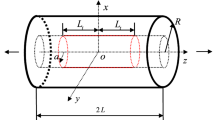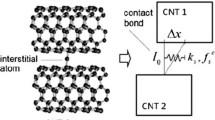By introducing a new simplified 3D representative volume element for wavy carbon nanotubes, an analytical model is developed to study the stress transfer in single-walled carbon nanotube-reinforced polymer composites. Based on the pull-out modeling technique, the effects of waviness, aspect ratio, and Poisson ratio on the axial and interfacial shear stresses are analyzed in detail. The results of the present analytical model are in a good agreement with corresponding results for straight nanotubes.
Similar content being viewed by others
References
S. Iijima, “Helical microtubes of graphitic carbon,” Nature, 354, 56-8 (1991).
D. Salvetat and A. Rubio, “Mechanical properties of carbon nanotubes: a fiber digest for beginners,” Carbon, 40, 1729-1734 (2002).
T. Thostenson, C. Y. Li, and T. W. Chou, “Nanocomposites in context,” Compos. Sci. Technol., 65, No. 3, 491-516 (2005).
D. Wagner and A. Lustiger, “Effect of water on the mechanical adhesion of the glass/epoxy interface,” Composites, 25, No. 7, 613-616 (1994).
Kin-tak Lau, “Interfacial bonding characteristics of nanotube/polymer composites,” Chem. Phys. Lett., 370, 399-405 (2003).
Gou, B. Minaie, B. Wang, Z. Liang, and C. Zhang, “Computational and experimental study of interfacial bonding of single-walled nanotube reinforced composites,” Comput. Mater. Sci., 31, 225-236 (2004).
J. Jortner, “A model for predicting thermal and elastic constants of wrinkled regions in composite materials. Effects of defects in composite materials,” in: ASTM STP 836, Amer. Soc. Test. Ma ter., Philadelphia, PA (1984), pp. 217-236.
Zhang, H. Y. Liu, Y. W. Mai, and X. Diao, “On steady-state fibre pull-out. I. The stress field”, Com pos. Sci. Technol., 59, 2179-89 (1999).
S. Shen, “Hydrothermal effects on the postbuckling of shear deformable laminated plates.” Int. J. Sol ids Struct., 43, 1259-1281 (2001).
Author information
Authors and Affiliations
Additional information
Russian translation published in Mekhanika Kompozitnykh Materialov, Vol. 45, No. 2, pp. 299-306, March-April, 2009.
Rights and permissions
About this article
Cite this article
Yazdchi, K., Salehi, M. & Shokrieh, M.M. Analytical and numerical techniques for predicting the interfacial stresses of wavy carbon nanotube/polymer composites. Mech Compos Mater 45, 207–212 (2009). https://doi.org/10.1007/s11029-009-9068-7
Received:
Published:
Issue Date:
DOI: https://doi.org/10.1007/s11029-009-9068-7




